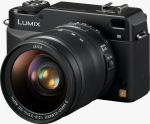 Panasonic details DMC-L1 plans
Panasonic details DMC-L1 plans
By
Mike Tomkins
(Wednesday, June 21, 2006 - 22:56 EDT)
Matsushita Electric Industrial Co. Ltd., whose digital cameras are sold under the Panasonic brand name, has today announced pricing, availability, and detailed specifications for its Lumix DMC-L1 digital SLR.
Compatible with Olympus' Four Thirds lens mount standard, the DMC-L1 is the company's first SLR. The L1 features a traditional, almost retro styling aesthetic and is based around the same 7.5 effective megapixel Live MOS image sensor that debuted in Olympus' EVOLT E-330 digital SLR, along with the mirror box unit from that camera (which combines a quick-return mirror, viewfinder, and AE sensor). Panasonic's proprietary Venus Engine III LSI handles the image processing, and Olympus' Supersonic Wave Filter makes its first debut in a non-Olympus branded camera, ensuring dust will not be bothering L1 users. As with the EVOLT E-330, the L1 offers a Live View function that allows images to be framed using the LCD display, regardless of whether you're focusing automatically or manually. In addition, you can use the LCD display as a handy confirmation of focus via an enlarged view when focusing manually. The L1 offers a 2.5" LCD display with 207,000 pixels, at the high end of what's available on digital SLRs at the current time. One other feature worthy of note is that the DMC-L1 offers a Secure Digital card slot, and is compatible with the FAT32 file system - meaning that Secure Digital cards larger than 2GB will be able to be supported. The Panasonic DMC-L1 will be sold bundled with a LEICA D VARIO-ELMARIT 14-50mm/F2.8-3.5 ASPH lens which was announced alongside the camera, and offers rings to control aperture, focus and lens zoom. Together the bundle will have a list price of $1,999 when the kit goes on sale this September. Newly revealed specifications include size, weight, image resolutions and aspect ratios, shooting speed (three frames per second for 6 Raw or unlimited JPEG frames), focusing (3-point phase difference detection), and ISO sensitivity (100 - 1600). Panasonic also revealed shutter speeds (60 - 1/4000 second, plus bulb exposures to eight minutes), flash modes / range, connectivity (USB 2.0 High Speed plus NTSC / PAL video), and more. Metering choices are multi, center-weighted or spot, with the multi mode offering 49 segments when using the optical viewfinder, and 256 segments in live view mode. Full specifications can be found below. We don't currently have any indication as to when we'll be receiving a test sample, but we're looking forward to bring you our usual detailed analysis of this interesting camera. | Panasonic Lumix DMC-L1 | 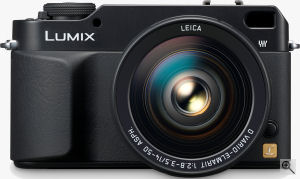 | | General | | Camera Type | SLR | | Manufacturer | Panasonic | | Model Number | DMC-L1 | | Dimensions | 5.7 x 3.4 x 3.1"
145.8 x 86.9 x 80.0mm | | Weight | 530.0 g
18.5 oz | | Planned Price | $1999.00 | | Planned Availability | Sep 2006 | | Image Capture | | Sensor Type | Four Thirds Panasonic N-MOS
7.94 megapixels (total)
7.50 megapixels (effective) | | Filter Type | RGBG | | Aspect Ratio | 4:3, 16:9 | | Image Dimensions | 3136 x 2352 (7.4 megapixels)
3136 x 2080 (6.5 megapixels)
3136 x 1760 (5.5 megapixels)
2560 x 1920 (4.9 megapixels)
2560 x 1712 (4.4 megapixels)
2048 x 1536 (3.1 megapixels)
2048 x 1360 (2.8 megapixels)
1920 x 1080 (2.1 megapixels) | | Capture Speed | Continuous: 3.0 frames per second | | Image Preview / Review | | Viewfinder | Yes, Eye level Porro Mirror type optical viewfinder
95% field of view | | LCD | 2.5", 207,000 pixels
100% field of view | | Playback Zoom | 16.0x max | | Lens | | Lens Type | Interchangeable Lens | | Lens Mount | Four Thirds | | Focusing System | 3 point TTL Phase Difference Detection with AF assist lamp
Manual Focus possible (0) steps | | Exposure | | ISO Sensitivity | Auto, 100, 200, 400, 800, 1600 | | Shutter Speed | 480 - 1/4000 second | | Exposure Modes | Aperture, Shutter, Manual | | Metering Modes | Intelligent Multiple (256-zone in live view, 49-zone with optical viewfinder), Center Weighted, Spot | | Exposure Compensation | +/- 2.0EV in 1/3EV increments | | White Balance | Image Sensor - Auto, Daylight, Cloudy, Shade, Halogen, Flash, White Set 1, White Set 2, Color temperature setting, Manual | | Internal Flash | Guide Number: 10
Modes: Auto, Auto/Red-eye Reduction, Forced On/Red-eye Reduction, Slow Sync., Slow Sync./Red-eye Reduction, Forced On/Off
Range: 10 meters at ISO 100 | | Flash Exposure Compensation | +/- 2.0EV in 1/3EV increments | | Creative | | Digital Zoom | 2x, 4x (live view mode only) | | Self Timer | Yes, 2 or 10 seconds | | Storage | | Recording Medium | SD/MMC | | File System | FAT16, FAT32 | | File Format | CCD-RAW, Raw, JPEG (EXIF 2.21) | | Connectivity | | Video | Yes, NTSC / PAL switchable | | Computer | USB 2.0 High Speed | | Power | | Battery Type | Lithium Ion rechargeable | | Battery Form Factor | Proprietary | | Product Bundle | | Software | LUMIX Simple Viewer, PhotofunStudio Viewer, Silkypix Developer Studio | | Battery / Charger | Proprietary Lithium Ion rechargeable battery and charger | | Flash Memory | 0.0MB | | Other | | Digital Print Order Format (DPOF) compliant | Yes | | PictBridge Compliant | Yes | | Tripod Mount | Yes, Metal | | Remote Control | Yes, DMW-RSL1 (Optional) | | More Photos | 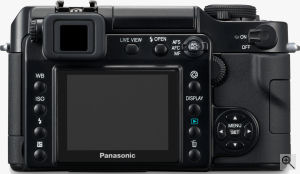 | 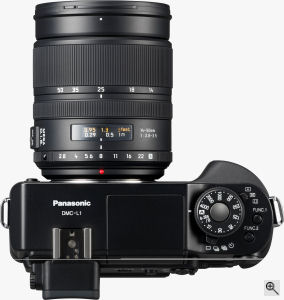 | 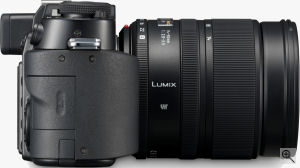 | 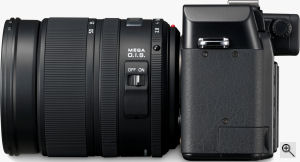 | 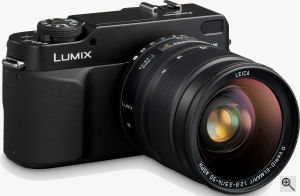 | 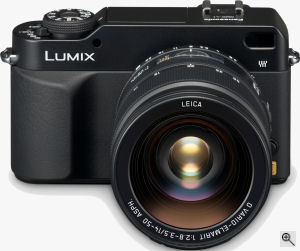 | 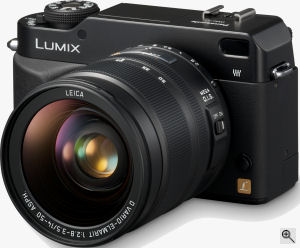 | 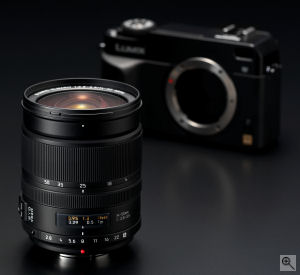 | | |
|
Original Source Press Release:
| Panasonic Announces Availability Of The Lumix DMC-L1 In The United States Company's First Digital SLR Camera Comes To North America
SECAUCUS, NJ (June 21, 2006) - Panasonic Corporation of North America (NYSE: MC) today announced the availability of its first digital single-lens reflex (SLR) camera with an interchangeable lens, the DMC-L1, in the United States. The camera will be available beginning early September for a suggested retail price of $1,999. The camera comes equipped with a LEICA D VARIO-ELMARIT lens featuring the industry's first optical image stabilization system - MEGA O.I.S - designed specifically for the Leica lens.
"With the DMC-L1, we confirm Panasonic's position as a leader in the imaging category," noted Rich Campbell, Director of the Imaging Group for Panasonic. "In this camera, we have incorporated today's most advanced digital technologies while maintaining the attractive look and operating feel of the traditional film camera. The DMC-L1 is the flagship model in our digital camera line. It delivers clear, detailed, beautiful imaging, free of unwanted digital characteristics, and allows advanced photographers and hobbyists alike satisfying, intuitive shooting from a digital SLR."
The DMC-L1 features a magnesium-alloy body, which closely resembles the body design of a rangefinder camera from days past, and combines an aluminum-alloy lens section to offer both high rigidity and a high-grade appearance. When combined with the shutter speed dial on the camera top and the aperture ring on the LEICA D VARIO-ELMARIT 14-50mm/F2.8-3.5 lens, the user receives easy, intuitive control of the exposure, rendering superior images.
The DMC-L1 ensures picture quality through incorporation of a Live MOS image sensor and a lens mount system that conforms to the Four Thirds™ Standard. A full-time Live View function uses a signal output directly from the Live MOS sensor, allowing users to view the same image on the LCD screen as seen by the sensor and to compose shots with greater ease and accuracy.
The camera also offers a dust reduction system that eliminates digital SLR cameras' long-standing problem of dust adhering to the sensor. Panasonic has solved this problem by equipping the DMC-L1 with a Supersonic Wave Filter system that uses supersonic vibration to shake off any dust clinging to the sensor. This simplifies camera maintenance and eliminates worries about dust entering the camera body when lenses are being changed.
By incorporating advanced imaging and power management with its Venus Engine LSI, optical image stabilization, and Leica lenses, Panasonic has created a premium line of digital cameras, now led by the DMC-L1.
About Panasonic Consumer Electronics Company
Based in Secaucus, N.J., Panasonic Consumer Electronics Company is a Division of Panasonic Corporation of North America, the principal North American subsidiary of Matsushita Electric Industrial Co. Ltd. (NYSE: MC) and the hub of Panasonic's U.S. marketing, sales, service and R&D operations. Information about Panasonic products is available at www.panasonic.com. Additional company information for journalists is available at www.panasonic.com/pressroom.
Extended Notes
A pleasure to hold and use
The DMC-L1 design reflects Panasonic's diligent pursuit of more than just high functionality. A shutter speed dial on the camera top enhances the user's sense of control. An aperture ring, along with a focus ring and zoom ring, is provided on the LEICA D VARIO-ELMARIT 14-50mm/F2.8 ASPH lens. These rings and the shutter dial combine to give the user quick, intuitive camera control for comfortable shooting in a range of situations. With the DMC-L1, users experience the responsive, satisfying performance that one would expect in a finely crafted camera.
The DMC-L1 also offers a high-grade appearance and high reliability and durability thanks to the use of a lightweight, high-rigidity magnesium alloy for the camera body. The body periphery and grip are covered with a textured, simulated leather that helps ensure a secure, slip-free hold.
Superb image rendering
The LEICA D VARIO-ELMARIT lens, the first interchangeable lens designed specifically for digital cameras to bear the Leica name, is a standard zoom lens developed jointly by and combining the optical technologies of Leica Camera AG and Panasonic. A new set of quality standards were created specifically for this lens, to ensure that it would bring out the best performance of the camera it is coupled with.
With a focal length range equivalent to 28mm (wide) to 100mm (medium telescopic) on a 35mm film camera, the Leica D lens provides exceptional results with everything from portraits to landscapes. This bright F2.8-3.5 lens allows maximum use of the out-of-focus techniques possible only with an SLR camera.
The lens also provides outstanding macro shooting, thanks to a 29 cm minimum shooting distance (0.32x maximum magnification, 35mm equivalent) across the entire zoom range. From landscapes to portraits to macro close-ups, the Leica D zoom lens excels in a wide variety of shooting situations.
The lens system comprises 16 elements in 12 groups and features two large-diameter glass-molded aspherical lenses. Meeting the Leica D lens lofty quality standards, this lens unit provides a superior optical performance and matches perfectly with the digital SLR camera body. The result is exquisite rendering, with images that offer clarity, depth, and rich expression from corner to corner, even at a fully open aperture.
The optical image stabilization system - MEGA O.I.S - provided in the lens unit helps minimize blurring to ensure that photos are sharp even in situations when hand-movement is typically a problem, such as when taking macro close-ups, indoor shots, or night portrait shots. Thanks to the gyrosensors and Venus Engine Plus LSI built into the lens, the system detects camera movement at a rate of 4,000 times per second, so hand-movement compensation is extremely precise.
There are two image stabilization modes. In Mode 1 the hand-movement compensation function remains active at all times, so the image in the LCD and viewfinder is clear, which makes shots easier to compose. In Mode 2 the system activates only when the shutter button is pressed; this provides a more precise compensation performance. Users can select whichever mode they prefer in a specific situation.
*The image stabilization system may not prevent blurring in all situations, such as when the shutter speed is extremely slow or there is excessive hand-movement or camera vibration.
Full-time Live View
Panasonic has developed a full-time Live View function that lets users accurately compose photos while viewing the high-resolution 2.5" LCD screen. In previous digital SLR cameras, a "live" image could be seen only through the viewfinder. The new full-time Live View function thus represents a dramatic change in digital SLR photography, giving users new ways to shoot.
Full-time Live View provides a 100 percent view field coverage (that is, the same image seen by the image sensor) on the DMC-L1's large, 2.5" LCD monitor. Users can compose a shot easily and accurately while viewing the screen. The screen also displays critical information such as a live histogram and white balance, which users can easily check prior to snapping the shot. When a tripod is used, full-time Live View lets users compose the image without bending to peer through the viewfinder. In these ways, users will find that full-time Live View gives them both more shooting flexibility and greater convenience.
The Live MOS image sensor must remain ON when full-time Live View is in use. The Live MOS sensor has a full-time image output function that sends a signal directly to the LCD, allowing high-quality display on the LCD screen of the same image seen in the sensor. Note that when the full-time Live View function is active, the internal mirror is in the raised position, which means that there will be no image visible in the optical viewfinder.
Users can take advantage of the revolutionary full-time Live View function in both Auto Focus and Manual Focus modes. When using Manual Focus, users can select a particular area within the frame and enlarge it up to 10x. Then, viewing the DMC-L1's 2.5" 207,000-pixel LCD screen, it is easy to check the focus. It is also possible, by pressing the aperture preview button, to check the depth of field. When the aperture is being adjusted, the DMC-L1 automatically adjusts the brightness of the full-time Live View image on the LCD screen to prevent it from becoming too dark to see. This makes it easier to check the depth of field.
4/3-type 7.5-megapixel, high-resolution, energy-saving Live MOS sensor
The Live MOS sensor used in the DMC-L1 provides beautiful images with delicate gradation and wide dynamic range that only a CCD image sensor can provide. To this it adds the low energy consumption only a CMOS sensor can offer. The use of dedicated processing technology enables operation at a low voltage of 5 V, minimizing noise in darker parts of an image. Also, photodiodes embedded deeply in the silicon layer create a structure that suppresses noise generated on the substrate surface. As a result, the white-spot pixel defects and textural roughness that often characterize images captured in dim lighting are minimized, so photos are crisp and clear.
Dust reduction system
One of the most critical issues with digital SLR cameras with interchangeable lenses is the possibility of dust entering the camera body during lens changes. This dust can adhere to the image sensor and show up as spots on photos taken. Panasonic has solved this problem by equipping the DMC-L1 with a Supersonic Wave Filter system that uses supersonic vibration to shake off any dust clinging to the sensor. This simplifies camera maintenance and eliminates worries about dust entering the camera body when lenses are being changed outdoors, so users can enjoy themselves and just concentrate on shooting.
Venus Engine III image processing LSI
The Venus Engine III is an image processing LSI developed by Panasonic to maximize the performance of the Leica D lens and Live MOS sensor. This advanced LSI not only helps reproduce images with outstanding resolution, superior color and detailed gradation, it also distinguishes chromatic noise from luminance noise and selectively reduces the chromatic noise, one of the chief sources of image quality problems. This helps the DMC-L1 deliver the superb image rendering one expects from a quality SLR camera. The Venus Engine III also works swiftly, helping give the DMC-L1 a quick startup time of 0.8 seconds, shorter shutter interval, and improved consecutive shooting performance.
Further, the Venus Engine III consumes 20% less power than its predecessor, the Venus Engine II. This combines with the Live MOS sensor's low energy consumption to give the DMC-L1 longer battery life. Users can take around 450 shots (CIPA standard) on a single battery charge.
Film mode
In film cameras, the brand of film used affects the color characteristics, gradation and color saturation of the photos taken. This gives photographers the option of choosing a particular brand of film to attain a particular desired effect. The DMC-L1 provides a similar option by giving the user a total of seven "film" modes to choose from, including four color settings (Standard, Dynamic, Natural and Smooth) and three monochrome settings (Standard, Dynamic and Smooth). Just as photographers can switch film brands to change the imaging characteristics, DMC-L1 users can switch modes to achieve a similar effect.
Two-axis white balance adjustment
In addition to the conventional white balance setting, the DMC-L1 features a two-axis setting system that allows even finer white balance adjustment. Making adjustments along a horizontal amber-blue axis and a vertical green-magenta axis, users can set the camera for detailed color cast compensation over virtually the entire color space.
Extra Optical Zoom*
When the camera is set to record at less than the maximum number of pixels, users can take advantage of an Extra Optical Zoom function*. This function alters the 7.5-megapixel Live MOS sensor's operating area, to vary the angle of view and increase the maximum zoom ratio.
Unlike a digital zoom, the Extra Optical Zoom function extends the focal length 1.5 times** (when shooting at 3-megapixel or a lower-resolution mode) without degrading the image. Users enjoy extra zoom power without loss of picture quality.
*Only applicable in using full-time Live View function.
**When the DMC-L1 is used with the LEICA D VARIO-ELMARIT 14-50mm/F2.8-3.5 ASPH lens provided.
Other features and functions - Supports SDHC format
- Compatible with external TTL flash units (models DMW-FL500, DMW-FL360)
- Auto bracket function - shoots three or five photos at exposures changing in steps of +1/3 to 1 EV
Equipped with a shutter-speed Bulb setting (8 minutes max.)
Variety of accessories
Leather Bag DMW-BAL1
Shoulder Strap DMW-SSTL1
Battery Pack CGR-S603
Remote Shutter DMW-RSL1
MC Protector DMW-LMCH72
PL Filter DMW-LPL72
External Flash (GN50) DMW-FL500
External Flash (GN36) DMW-FL360 |
Powered by Coranto
|